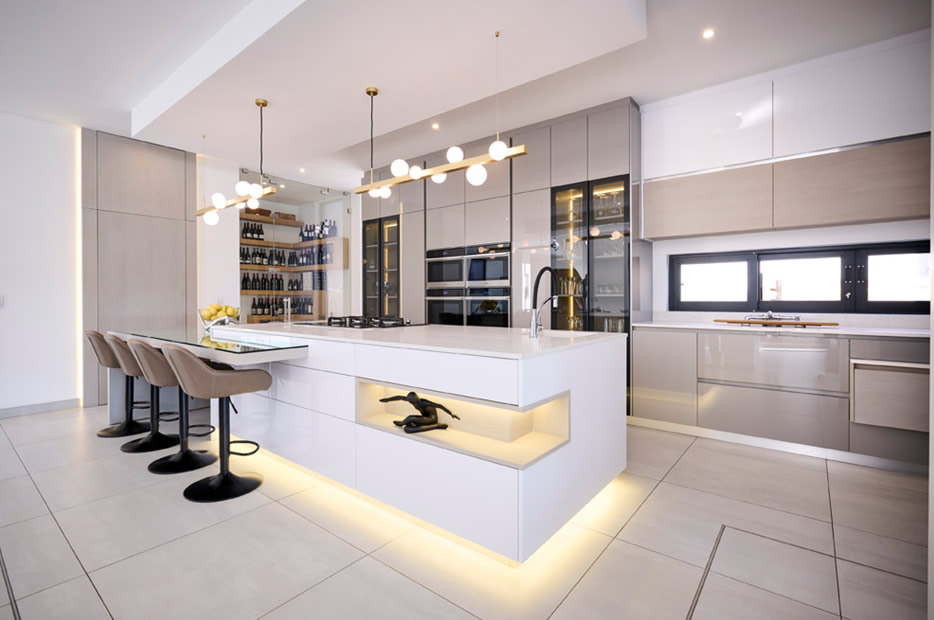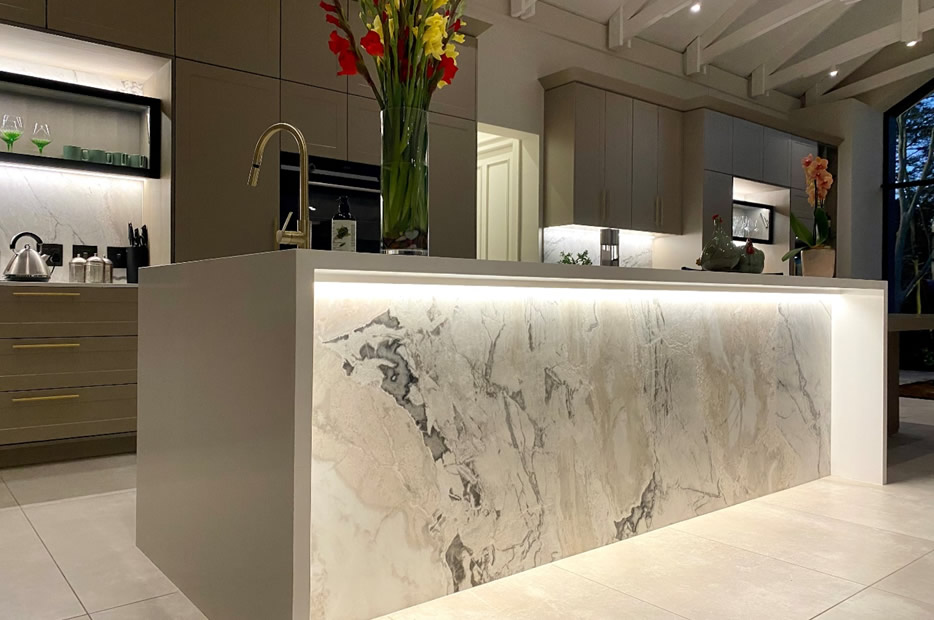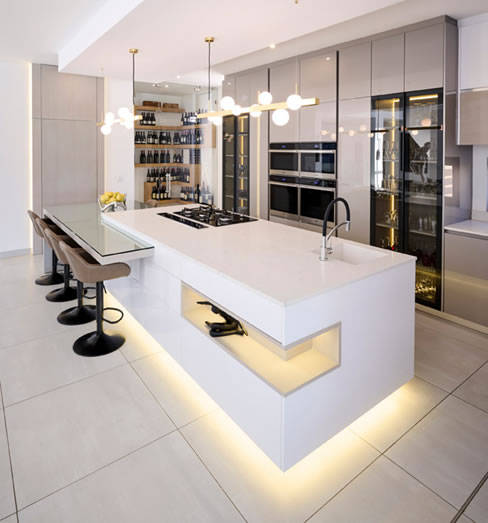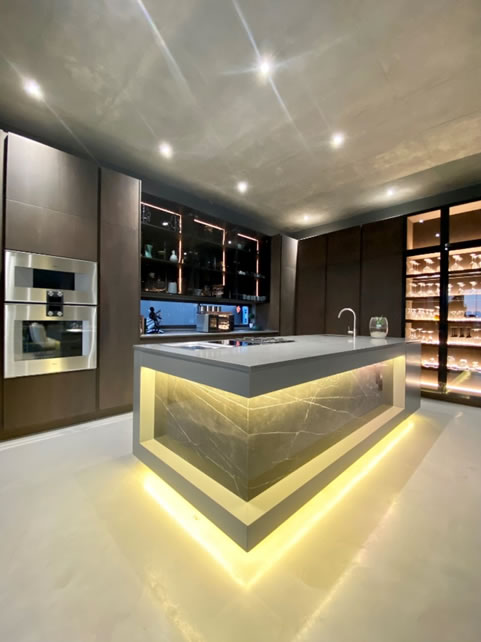How to choose a timeless kitchen
By Selma Zaifoglu
Choosing a timeless kitchen design is important as it ensures that your kitchen will be stylish and relevant for years to come. Here are some tips on how to choose a timeless kitchen:
Neutral color palette
Opt for neutral colors like white, cream, or gray for your kitchen cabinets, walls, and countertops. These colors are timeless and will create a clean and ageless look.
Classic cabinet design
Choose cabinet doors with a classic design such as shaker style or flat panel. Avoid trendy cabinet styles that may become outdated in a few years.
Quality materials
Invest in high-quality materials for your kitchen countertops, backsplash, and flooring. Natural stones like granite or marble, and durable materials like quartz or porcelain are timeless choices that will stand the test of time.
Simple hardware
Select simple and timeless hardware for your cabinets and drawers. Classic options like brushed nickel or stainless steel knobs and handles will never go out of style.
Timeless fixtures
Choose fixtures such as taps and lighting that have a timeless appeal. Opt for classic finishes like brushed nickel or oil-rubbed bronze that will not go out of style.
Avoid trendy accessories
While it's fun to add pops of color and personal style to your kitchen, avoid incorporating trendy accessories that may become outdated quickly. Instead, opt for timeless accessories like simple glass vases or classic tableware.
Functional layout
Focus on a functional kitchen layout that is efficient and practical. Timeless kitchens are designed with usability in mind, with a clear and logical flow between the different work zones.
Classic flooring
Choose flooring materials that are timeless and durable. Hardwood or stone flooring in neutral shades are excellent options that will suit any kitchen style.
Keep it simple
Lastly, keep the overall design of your kitchen simple and uncluttered. Avoid excessive ornamentation or over-the-top details that may date quickly. Less is often more when it comes to creating a timeless kitchen design.
By following these tips, you can create a kitchen that will stand the test of time and remain stylish and relevant for years to come.




2023 luxury kitchen trends
By Selma Zaifoglu
Here are some luxury kitchen trends that are gaining popularity in 2023:
Minimalistic and Sleek Designs
Clean lines, minimalistic aesthetics, and sleek finishes are becoming more popular in luxury kitchen designs. Clutter-free countertops and hidden storage solutions contribute to a sense of elegance and spaciousness.
Mixed Materials and Textures
Combining different materials and textures, such as natural stone, wood, glass, and metal, adds visual interest and depth to luxury kitchens. These combinations create a unique and luxurious ambiance.
Bold Colors and Contrasts
While neutral color palettes are still favored, there is a growing trend toward incorporating bold colors and high-contrast elements. Dark greys and matte black are some of the colors making their way into luxury kitchen designs.
Open Shelving and Display Areas
Open shelving and glass-front cabinets are used to showcase beautiful dishware, glassware, and decorative items. This trend adds a touch of sophistication and personalization to kitchen spaces.
High-End Appliances
Luxury kitchens are equipped with top-of-the-line appliances that featured advanced technology, energy efficiency, and cutting-edge functionalities. Built-in coffee makers, steam ovens, and integrated wine coolers are some examples.
Statement Lighting Fixtures
Unique and artistic lighting fixtures are being used as focal points in luxury kitchens. Chandeliers, pendant lights, and intricate ceiling fixtures add both functional and aesthetic value.
Natural and Sustainable Elements
Incorporating sustainable and eco-friendly materials, such as reclaimed wood and recycled glass, is a growing trend in luxury kitchen design. These elements reflect a commitment to environmental responsibility.
Multi-Functional Islands
Kitchen islands are designed to serve multiple purposes beyond just food preparation. They often includ built-in sinks, seating areas, storage solutions, and even integrated stovetops.
Integrated Spaces
Luxury kitchens are increasingly designed to seamlessly integrate with other living spaces, such as dining and living areas. This open layout promotes a sense of connectivity and enhances the overall living experience.
Focus on kitchen designs & layouts
By Selma Zaifoglu
The best kitchen island designs enhance your kitchen space immensely, be it through adding storage or creating a relaxed dining or seating area. The island will become the heart of the kitchen, allowing for a flow that will make both cooking and socialising a real pleasure. You can choose to incorporate integral kitchen features into your island, such as a hob or a sink, keep it the reserve of storage with drawers or open shelving, or use it primarily as a central breakfast bar.
The Kitchen Layout
The single-wall kitchen layout features cabinets and appliances located against a single wall. For small homes, like studio apartments and lofts, this format keeps everything within easy reach. Note, however, that this kitchen layout does not use the work triangle. Instead, components are organized by working area to make the space flow more intentionally.
Also known as corridor kitchens, the galley layout is a lean and efficient option for small kitchens and snug spaces. Two walls facing each other characterize this kitchen layout.
The L-shaped kitchen layout is streamlined and dynamic. It features units built on two sides of a corner and plenty of work surfaces.
A U-shaped kitchen layout wraps around three walls, defining the cooking zone and dividing the kitchen from the rest of the house. Also know as horseshoe kitchen layouts, U-shaped kitchens provide plenty of storage space, allow for great workflow and let multiple users navigate the kitchen together.
One of the most sought-after kitchen trends is the Island layout. An adaptable solution, the island can be the main prep surface in the kitchen, a cooking centre, or a washing centre – or both. Kitchen islands are astonishingly functional.
A Peninsula kitchen is a U-shaped kitchen layout with a connected island. Some peope call this a G-shaped design because of the shape the attached island creates. Peninsulas offer a similar traffic pattern to island kitchens, but provide more leeway and workspace within reach. This is a great solution where space doesn’t support an independent island.
What to consider when selecting a kitchen layout
The initial step to take is to decide on the kitchen layout before you even get into every detail. This entails considering where to position the kitchen main parts and components – the kitchen sink, countertop, fridge, table, and chairs. Make sure the whole layout looks structured and streamlined.
After the layout, kitchen storage plays a crucial part. As there are many kitchenware involved and food items to store, you want to utilize and make ample space for storage.
The kitchen lighting shouldn’t be neglected as it is what creates the perfect ambience for your kitchen. With the right lighting, it will set the mood of your kitchen. Apart from this, the variety of light sources in your kitchen will help you cook and prepare food safely. There are many lighting options to consider for your kitchen. For instance, you may want to incorporate ambient lighting for the entire room or add pendants for lighting enhancement.
The kitchen flooring is one part that shouldn’t be taken for granted. This is because improper flooring can compromise the safety of the entire household.
While you’re at it, you have to consider the proper ventilation as well. Ventilation ensures the right circulation of air in your kitchen. It is vital when you cook or prepare food and is all the more crucial when maintaining the smell of your kitchen.
Selecting a kitchen company with architectural expertise can indeed be a beneficial decision, as it can lead to a more well-designed and functional kitchen space.Remember that while architectural expertise is valuable, it's also important to find a company that can effectively collaborate with you and bring your vision to life.



Focus on contemporary kitchens
By Selma Zaifoglu
A contemporary kitchen is characterized by its design that reflects the current popular styles and trends in interior design. It doesn't adhere to a specific period but rather evolves with the changing preferences and aesthetics of the present day. This style borrows elements from various design movements like modernism, minimalism, and even art deco, while not overly fixating on anyone.
In a contemporary kitchen, you can expect to see a blend of clean lines, sleek surfaces, and a focus on functionality. Neutral colour palettes are often used as a base, but bold accents and pops of glam might also be integrated to add visual interest. The design aims to create a harmonious balance between form and function, often incorporating innovative technologies and materials.
Furniture and fixtures in a contemporary kitchen tend to be simple and streamlined, with an emphasis on practicality and efficiency. Open shelving, hidden storage solutions, and integrated appliances are common features. Natural light is often maximized through large windows or strategically placed light sources to create a bright and inviting atmosphere.
Ultimately, a contemporary kitchen is a dynamic blend of various design influences, resulting in a space that feels current, stylish, and adaptable to the changing tastes of the time.Remember, a contemporary kitchen should reflect your personal style while embracing the principles of modern design.
Luxury kitchen renovations
By Selma Zaifoglu
Starting a high-end kitchen renovation requires careful planning and consideration to ensure that you achieve the desired results. Here are some important first steps to consider:
Define Your Goals and Budget
Clearly outline your goals for the renovation. What specific features, materials, and appliances do you want in your luxury kitchen? Set a realistic budget that aligns with your goals to avoid overspending.
Hire Professionals
Engage with experienced professionals such as architects, interior designers, and kitchen designers who specialize in high-end renovations. Their expertise can help you create a functional and aesthetically pleasing space.
Assess Existing Space
Evaluate your current kitchen layout and identify its strengths and weaknesses. Consider the flow of the space, natural lighting, and any structural limitations that might affect your design choices.
Conceptualize Design
Work closely with your design team to create a concept that reflects your style and preferences. Consider factors such as color schemes, materials (stone, wood, metal), cabinetry styles, and overall aesthetics.
Functional Layout
Focus on creating a functional layout that supports efficient cooking, meal preparation, and movement within the kitchen. The kitchen work triangle (connecting the sink, stove, and refrigerator) is a fundamental principle to consider.
Appliance Selection
Choose high-quality appliances that align with your cooking habits and needs. Consider professional-grade ranges, built-in ovens, top-of-the-line refrigerators, and other appliances that complement the overall design.
Customization and Personalization
Luxury kitchen renovations often involve custom solutions. Tailor cabinetry, storage solutions, and other elements to your specific requirements. This is where your personal touches can shine.
Material Selection
Select premium materials for countertops, backsplashes, flooring, and cabinetry. Consider options like marble, granite, quartz, hardwood, and high-end finishes to enhance the luxurious feel of the space.
Lighting Design
Plan for a layered lighting scheme that includes ambient, task, and accent lighting. High-end kitchens benefit from well-designed lighting that enhances both functionality and aesthetics.
Permitting and Regulations
Ensure that your renovation plans comply with local building codes and regulations. Obtain any necessary permits before starting the renovation to avoid delays and legal issues.
Project Timeline
Work with your professionals to establish a realistic project timeline. High-end renovations can take time, and it's important to have a clear understanding of when different phases of the project will be completed.
Communication
Maintain open and frequent communication with your design team, contractors, and any other professionals involved in the project. Regular updates will help ensure that everyone is aligned and any potential issues are addressed promptly.
Sourcing and Ordering
Begin sourcing the materials, appliances, and fixtures required for the renovation. High-end products might have longer lead times, so it's important to start the ordering process early.
Demolition and Construction
Once all the planning and preparations are in place, start the renovation process. This typically involves demolition of the existing space and construction based on the new design.
Quality Control
Throughout the renovation, conduct regular quality checks to ensure that the work is being executed according to the design specifications and industry standards.
Remember that a high-end kitchen renovation requires attention to detail, patience, and a clear vision of the final result. By following these steps and working closely with professionals, you can create a luxurious and functional kitchen that meets your unique needs and preferences.





Elements of a modern kitchen
By Selma Zaifoglu
A well-designed modern kitchen should be functional, efficient, and aesthetically pleasing. While preferences can vary, here are some essential elements that every kitchen should include and the reasons behind their importance:
The Work Triangle
The concept of the work triangle involves positioning the three key work areas – the stove, refrigerator, and sink – in a triangular layout. This arrangement optimizes efficiency by minimizing unnecessary movement while cooking.
Adequate Storage
Storage is crucial for keeping the kitchen organized and clutter-free. This includes cabinets, drawers, pantry space, and shelving. Tinted glass cabinetry with hidden LED lighting can add a modern touch while showcasing your dishes and utensils.
Quality Appliances
High-quality appliances are essential for efficient cooking and food preparation. These include a stove/oven, refrigerator, dishwasher, and microwave. Select appliances that suit your cooking habits and needs.
Ample Countertop Space
Having enough countertop space is crucial for food preparation, cooking, and even serving. Stone worktops not only provide durability but also contribute to the overall aesthetics of the kitchen.
Proper Lighting
Adequate lighting is essential for safety and functionality. Hidden LED lighting in tinted glass cabinetry can provide both ambient and task lighting, while pendant lights above work areas can offer focused illumination.
Ventilation
A good ventilation system, like an exhaust hood or range hood, helps to remove cooking odors, heat, and grease from the kitchen, maintaining air quality and comfort.
Sink Area
The sink is where food is prepared and dishes are cleaned. A deep, durable sink with a flexible faucet can make washing dishes and food preparation more convenient.
Backsplash
A backsplash protects the walls from splatters and spills while also adding an opportunity for design flair. Matte finishes with mirror elements can contribute to the modern aesthetic you're aiming for.
Flooring
Choose flooring materials that are durable, easy to clean, and can withstand the high-traffic nature of a kitchen.
Electrical Outlets
Place electrical outlets strategically throughout the kitchen for appliances, gadgets, and charging devices. Having enough outlets can prevent the need for extension cords and make your kitchen more versatile.
Waste Management
Incorporate proper waste disposal systems, such as trash and recycling bins, to keep the kitchen tidy and eco-friendly.
Seating Area
If space permits, a seating area like a kitchen island with stools or a small dining table can provide a space for casual meals and socializing.
While the specific design choices like tinted glass cabinetry, matte finishes, mirror elements, and stone worktops can certainly add a modern touch and elevate the aesthetics of your kitchen, it's important to ensure that these choices align with your overall functional needs and personal preferences. A balanced approach that combines functionality, aesthetics, and your own cooking habits will result in a kitchen that's not only visually appealing but also highly practical.
Fundamental features your kitchen
By Selma Zaifoglu
The central elements of design are space, line, form, colour, and texture. Learning about these concepts and their applications will help you make your kitchen look good and feel good for all that enter your space!
Less is more when it comes to the modern kitchen, and you won’t find cluttered benchtops or fussy accessories. Instead, personality is brought in through practical features such as coloured splashbacks using Onyx or marble.
Today, onyx symbolizes extravagant luxury in modern kitchen design. Onyx can be backlit, due to the translucency of the stone. Backlit onyx creates a dramatic impact while becoming the focal point of the room.
Marble is an all-natural stone product that is mined from the earth. It offers timeless beauty and white brightness. Despite its classic looks, marble is also one of the less expensive choices in natural, hard-wearing stone surfaces. Marble is heat resistant, therefore kitchen marble won't yellow due to the heat and can withstand the occasional spark on its surface. Its drawback though is that it is porous and can stain if not cared for correctly.
Another idea we absolutely love is the use of glass-fronted cabinets or vitrines as additional kitchen storage. While the concept seems rather traditional, these types of cabinets can easily fit into any style of kitchen. A cabinet with glass doors allows for practical storage as well as bringing a luxury element into your kitchen. It also allows your dishes to become part of the show – a focal point.


The age-old question: brass versus copper?
By Selma Zaifoglu
We all have fond memories of sitting in Granny’s kitchen, surrounded by her copper pots and gleaming brass taps. However, the world has certainly evolved since those times. The plastic period, as some like to call it, has now started to giveway to the era of metals once again. Copper and brass, especially with a vintage finish, are the latest revelation in the world of interior designof homes. Metallics offer a simple and effortless touch of style to any room. Currently, adding a touch of brass or copper to your interior decoration is synonymous with a vanguard look.
With this trend it’s best to keep it simple when using metallics in the home; too much metal and it becomes overdone so opt for accents here and there – a brass lantern next to the fireplace, for example, or a statement pendant copper light in a clean white room offset with touches of black and light grey. Choose different styles, finishes and textures, too, for a natural – rather than contrived –look.
In the kitchen, introduce metallics with accessories, cutleryand a small appliance perhaps. One of the best ways to incorporate brass and copper in the home is through lighting. Statement-making without being too flashy, ametallic pendant light will look good in most areas. For timeless yet contemporarystyles, go for a copper bowl pendant lamp.
Brass finishes have always been a constant, timeless look in the home and especially kitchens, whilst copper is a more modern addition. Now we are seeing less and less copper accents and find that brass, with its agelessness, is making a strong reappearance. Going forward the use of brass elements instead of copper will become more prevalent, due to its endurance and intransience.
PROUDLY TRUSTED BY
